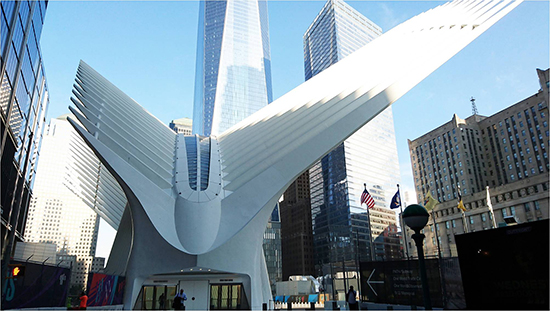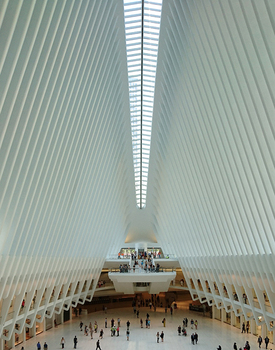|
Subscribe / Renew |
|
|
Contact Us |
|
| ► Subscribe to our Free Weekly Newsletter | |
| home | Welcome, sign in or click here to subscribe. | login |
Architecture & Engineering
| |
 |
January 23, 2017
National finalist: Gold award
Structural systems
COWI North America

Project: World Trade Center Transportation Hub
Client: The Port Authority of New York and New Jersey

One hundred feet above the ground at the tip of New York’s Manhattan Island, a giant steel-and-glass, dome-like structure rises over the new World Trade Center Transportation Hub.
The eye-catching structure, designed by world-renowned architect Santiago Calatrava, is inspired by what appears to be a pair of hands releasing a white dove. The structure, called Oculus, consists of two parallel arches spanning a 300-foot-long oval-shaped opening in the roof, supported by columns spaced five-and-a-half-feet apart. Glass panels fit in between the columns, allowing natural light to bathe the 200,000 daily commuters below.
Yes, it is beautiful and inspiring, but it also was an extremely complex and complicated structure to design and build. In fact, because of its bridge-like design, the Port Authority of New York and New Jersey didn’t seek out a traditional structural engineering company to help build it. Instead, the port hired for the project a top bridge-engineering firm, COWI North America, and its New York bridge division, Buckland & Taylor International.
Santiago Calatrava was the lead design and calculating engineer.
(Editor’s note: The article has been changed to clarify Santiago Calatrava’s engineering role.)
A sequential erection scheme, used in bridge construction, was deemed the ideal approach. Essential to this scheme was a custom “finite element analysis” model that determined the cambered shape of each individual steel segment and computed the stresses in the structure and the position of the geometry control points during each stage of the erection.
Constant monitoring with the model helped define erection sequence, maintain tight geometric tolerances, achieve schedule and reduce costs, and allowed for slight alterations and adjustments as construction progressed.
The project team also identified significant risks associated with traditional “field welding.” To mitigate these risks, COWI replaced welded splices in the arches with bolted connections. Fully connecting an arch piece by field welding required almost three weeks, but with bolts, the connection could be completed in two days.
Dan Payea, a vice president for Skanska, the contractor, wrote, “Applying bridge engineering concepts and first principles to the erection of the building allowed this highly complex project to be completed safely and accurately.”
Awards judge Jeff Carpenter, state design engineer for the Washington State Department of Transportation, added, “COWI’s Oculus structural lift plan highlighted the challenges engineers can face when embracing bold architecture.”
Other Stories:
- National finalist: Platinum award
Environmental design
Magnusson Klemencic Associates - Best in state: Gold award
Complexity
Wood Harbinger - Best in state: Gold award
Complexity
BergerABAM - Best in state: Gold award
Social, economic and sustainable design
Landau Associates - Best in state: Gold award
Future value to engineering profession
DLR Group - Best in state: Gold award
Unique or innovative applications
Otak - National finalist: Gold award
Transportation
McMillen Jacobs Associates - National finalist: Gold award
Water resources
Shannon & Wilson - National finalist: Gold award
Waste and stormwater
Brown and Caldwell - National finalist: Gold award
Structural systems
HDR Engineering - National finalist: Gold award
Studies, research and consulting
WSP Parsons Brinckerhoff/EnviroIssues - Best in state: Gold award
Successful fulfillment of client/owner needs
Welch Comer Engineers


